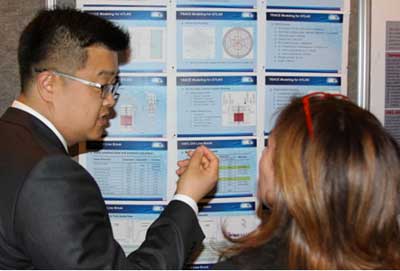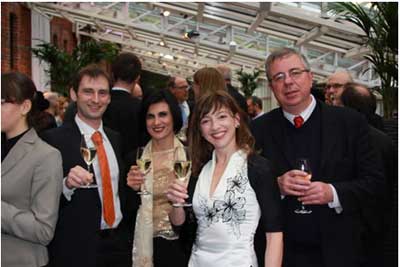

TopSafe 2012: The post-Fukushima Era
From 22-26 April, the TopSafe 2012 conference took place in Helsinki, under the auspices of the European Nuclear Society (ENS) and the International Atomic Energy Agency (IAEA).
Barely a year after the Fukushima nuclear accident sufficient knowledge has been gained about the detailed sequence of events that lead to the complete blackout of several reactor units at the Fukushima Daiichi and Fukushima Daiini sites. With such a compilation of data and supporting analyses relating to the accident now available, the timing for TopSafe 2012 was especially appropriate.
As a result of the Fukushima accident, several countries have subjected their nuclear energy programmes to thorough scrutiny. In view of this, the nuclear industry and nuclear research institutions are carrying out a thorough process aimed at understanding the causes and consequences of such events, as well as the lessons to be learnt from them.
The Opening and Plenary Sessions of the conference defined the scope of the subsequent presentations and poster sessions, and underlined the actions undertaken by different international organisations since the accident. In Europe the rapid coordinated countermeasures that were taken, e.g., the so called “stress tests,” significantly diminished the negative impact of the accident upon public opinion.
Tero Varjoranta, Director General of the Finnish Nuclear and Radiation Safety Authority, STUK, stated that trust is hard to earn but easy to lose, which makes every accident, and even lesser incidents, extremely harmful to the nuclear industry. In Finland, STUK is one of the most trusted authorities and during the Fukushima accident it was the main source of information for media and public alike. This effectively decreased the public’s level of anxiety. The authority was aware of the situation and of the reports of possible hazards. Sometime after the accident occurred, STUK reported that it had detected a few dozen micro bequerels of iodine from Fukushima per cubic meter of air, a fact that was notified almost exclusively by the tabloid press and didn’t make the headlines in the broadsheets.
The highlight of the first Parallel Session, entitled Lessons Learned from Fukushima, was the presentation by Akira Kawano, from the Tokyo Electric Power Company (TEPCO), in Japan. Mr. Kawano's presentation provided first-hand information about the development of events at Fukushima since the earthquake of March 11, 2011.
In the aftermath of the tsunami that struck the Eastern coast of Japan, workers and operators at the Fukushima site had to work under very tough and restrictive conditions, including a lack of electrical power, high radiation doses, lack of instrumentation readings, the threat of a hydrogen explosion hazard and the debris caused by the earthquake and subsequent tsunami. His presentation put into perspective the human dimension of the crisis, during which several workers agreed to put their lives at risk in order to secure the opening of the pressure relief valves.
The session that ran parallel to the Lessons Learned from Fukushima one focused on external hazards. Alain Chabod, from AREVA, reviewed the safety features of the EPR within the post-Fukushima context. His presentation gave an analysis of the robustness of the EPR design in the face of extreme external hazards, such as earthquakes, external flooding and total loss of outside power or ultimate heat sink. He concluded that the EPR design provides good resistance and margin to cope with Fukushima-type accidents. But, nevertheless, some additional measures have been identified to further eliminate possible cliff-edge effects.

The Monday morning started with a poster session
Moving on to the Best Estimate Codes and Methods session, speakers from nuclear research institutes and nuclear design and construction companies shared the results they have obtained from several safety-related analyses, mostly dealing with the simulation of transients in LWRs. This series of presentations triggered very fruitful discussions about the necessity of best estimates and uncertainty calculations being accepted by licensing bodies. Participants active in the fields of design and licensing launched debates on this issue.
The second parallel session of the Tuesday morning, which focused on safety assessments, included an interesting review of the safety design of the new AP1000 reactor. The accident that featured in this session was a small break LOCA and the presentations focused on the impressive passive mitigation features of the design. In the same session representatives of the NRG (the Dutch Nuclear Energy Consultancy), gave a talk about the key differences between the various European EPR designs. The study that the talk was based on analysed the principal differences between the Olkiluoto and the Flamanville/UK EPR designs, concentrating on why there are differences between the two. While country specific regulations were identified as the main reason for these differences, several other reasons were also identified.
In another session, which was also related to best estimate calculations, a very interesting presentation about hydrogen combustion analyses by CFD methods was given. Although the representation of non-uniform hydrogen concentration is still under development, this methodology looks promising not only to assess the evolution of hydrogen combustion, but also to assess the impact of such combustion on the systems, structures and components of nuclear power plants. During this session the development and qualification of an atmospheric monitoring system was also discussed.
Towards the end of the second day, a session was devoted to the topic of Safety Culture & Management of Safety. The presentations given during this session made it very clear that, unless appropriate programmes are implemented, a considerable amount of the knowledge gained by nuclear designers and operators over the years may be lost due to the retirement of a significant percentage of them. Although this shortfall in knowledge management was identified several years ago, not all affected parties have implemented the policies needed to overcome the problem. At present, the IAEA is working on a paper that reflects the experience cumulated in the reinforcement of safety culture through knowledge management initiatives.

The conference dinner was held at the Ravintola Sipuli, in an excellent setting
On the last day, the topics discussed ranged from education, training and risk-informed decision making to future nuclear installations. In the latter session some aspects of lead-bismuth cooled reactors, as well as pebble bed and fusion reactors, were examined.
Dr. Harri Tuomisto gave an interesting presentation on the unexpected in the nuclear industry. He described the ``Black Swan'' context, which refers to a highly unlikely event that has considerable consequences and for which there was no prior hint that it might occur. He came to the conclusion that all three major accidents, Three Mile Island (TMI), Chernobyl and Fukushima, fall into cthe ategory of known unexpected accidents and as such are not “Black Swans”. The WASH-1400 report by Rasmussen et al. revealed the possibility of a TMI-like accident. The positive feedbacks from RBMK were also known about (but apparently not by operators). Furthermore, historical data clearly reveals the possibility of tsunamis exceeding 10 meters in height occurring in Japan.
Dr. Tuomisto’s presentation generated a lively discussion on the existence and justification of residual risk and of whether the Fukushima accident was a residual risk or not. In Dr. Risto Himanen's opinion, there is no such thing as a residual risk and there are only higher probability and lower probability risks. For practical reasons actions are first taken in response to more probable risks. However, low probability risks are not neglected. Instead, they are reconsidered if their relative importance has increased as a result of actions taken in response to other risks. The audience seemed to be unanimous in the view that the Fukushima accident could not be categorised as a residual risk, even if such risks do exists. However, with proper PSA, including the external events, the core damage frequency would have been closer to 10^-2/a rather than the 10^-4/a given prior the accident.
After all the sessions had concluded, the closing session of TopSafe 2012 featured presentations on nuclear knowledge management and global nuclear safety and security. After these presentations, general information about conference participation and research was communicated. Then a final Questions and Answers session took place, during which the main emphasis was on the aftermath of the Fukushima accident and on the views of the nuclear industry with regards to the future.
A debate on the consideration of beyond-design-basis events as a licensing requirement then took place. Debate on this issue revolves around the re-consideration of what is deemed to be an “acceptable risk” for the nuclear industry. Although the debate remains an open one, the main encouraging conclusion of this conference is that, in spite of the crisis experienced by the nuclear sector in 2011, growth is still foreseen. However, additional safety analyses and tests may be required, and those countries that were committed to nuclear energy before 11 March 2011 are still committed to nuclear power generation today.
TopSafe 2012 culminated in a technical visit to the Visitor Center and underground repository for low- and intermediate-level waste at the Olkiluoto NPP. The EPR at Olkiluoto is almost finished on the outside, but interior work continues and the planned start-up of operations is 2014. Even from a distance the plant was impressive, with the two operating medium-sized BWRs next to it.
Eric Dorval, Lauri Rintala, Ville Valtavirta
ENS-YG Reporters
Aalto University, School of Science
|

